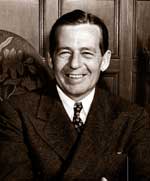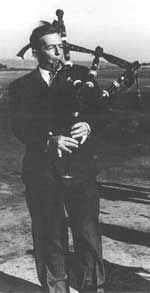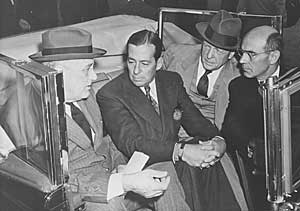
 Donald Wills Douglas, the second son of an assistant
cashier of the National Park Bank, was born in Brooklyn, New York, April
6, 1892, and started his education at Trinity Chapel School in New York
City. At the age of 17, Donald Douglas entered the U.S. Naval Academy at
Annapolis where he spent much of his time building and testing model
airplanes. Douglas' family, fellow midshipmen and professors thought his
interest in aviation would pass. They were very surprised when he left the
Naval Academy in 1912, before he graduated, to look for work in
aeronautical engineering. Donald Wills Douglas, the second son of an assistant
cashier of the National Park Bank, was born in Brooklyn, New York, April
6, 1892, and started his education at Trinity Chapel School in New York
City. At the age of 17, Donald Douglas entered the U.S. Naval Academy at
Annapolis where he spent much of his time building and testing model
airplanes. Douglas' family, fellow midshipmen and professors thought his
interest in aviation would pass. They were very surprised when he left the
Naval Academy in 1912, before he graduated, to look for work in
aeronautical engineering.
He soon realized he needed to learn more about his chosen
career field and completed the four-year bachelor of science program at
the Massachusetts Institute of Technology in only two years. Because of
his academic performance, Douglas was immediately hired at MIT as an
assistant professor in aeronautics.
In 1915, he became a consultant to the Connecticut
Aircraft Co. and helped build the first Navy dirigible. In August of the
same year, he joined the Glenn L. Martin Company, then in Los Angeles, as
chief engineer. In 1916, he served briefly as chief civilian aeronautical
engineer for the Army Signal Corps Aviation Section in Washington, D.C.,
and married Charlotte Marguerite Ogg in Riverside, California. He took her
back to Cleveland, Ohio, where Martin had relocated. As chief engineer,
Douglas was in charge of building for the U.S. Army the MB-1 twin-engine
bomber, which first flew Aug. 17, 1918, and its transport derivative.
In chilly Cleveland, Douglas and his family missed the
balmy California climate, so in January 1920, his wife took their two sons
back to Los Angeles, and he joined them in March. Douglas was determined
to make it on his own, in spite of having only $600 and a family to
support. To provide for his family, he worked as a laborer, hoeing
potatoes and washing cars. His first aircraft order was from millionaire
sportsman David R. Davis, who put up $40,000 to build an airplane to make
the first nonstop, coast-to-coast flight.
The Davis-Douglas Company was formed to build The
Cloudster, which did not complete the flight, but did become the first
aircraft to lift a useful load exceeding its own weight. It ultimately
became the flagship of Claude Ryan's San Diego-to-Los Angeles airline.
Davis lost interest and sold out to Douglas, who incorporated The Douglas
Company in July 1921. He finally landed his own Navy contract -- to build
torpedo bombers, starting with the DT-1 (Douglas Torpedo, First).
By 1922, the company had delivered six aircraft for
$130,890. Douglas leased the abandoned buildings of the Herman Film
Corporation at 2345 Wilshire Boulevard in Santa Monica, California, where
he built the Douglas World Cruiser. By the fall of 1928, the company was
worth $25 million.

Despite the 1929 crash that started the Great Depression,
Douglas kept his company alive and financially sound building military
aircraft. In 1932, he started building the DC-1 and launched his career as
a builder of transports. By 1940, sales of DC-2 and DC-3 transports and
their military derivatives rose to nearly $61 million.
To keep up with World War II production, Douglas built
plants at Long Beach and El Segundo, California, and leased facilities in
Chicago, Oklahoma City and Tulsa, Oklahoma. The leased plants were closed
at the end of the war, but Douglas continued to produce commercial and
military transports, jet fighters, missiles and rockets.
Donald Wills Douglas Sr. was company president until 1957,
when his son, Donald Douglas Jr., took over that position. Donald Douglas
Sr. remained chairman of the board. At the age of 75, on April 28, 1967,
Douglas merged his company with the McDonnell Aircraft Company and
retired. He remained honorary chairman of the McDonnell Douglas board
until his death on Feb. 1, 1981.
He lived for almost a century and presided over the birth,
the growth and the evolution of the aerospace industry.
 |
| This 63mm bronze medallion commemorates the 40th
anniversary of the Douglas Aircraft Company and its founder, Donald
W. Douglas; the reverse side has "Wings for the world by Douglas"
with images of the 1920 Cloudster and the 1960 DC-8. |
See also:
Video of Donald Douglas remembering seeing the Wright Brothers as a
young boy in 1908.
|
|


